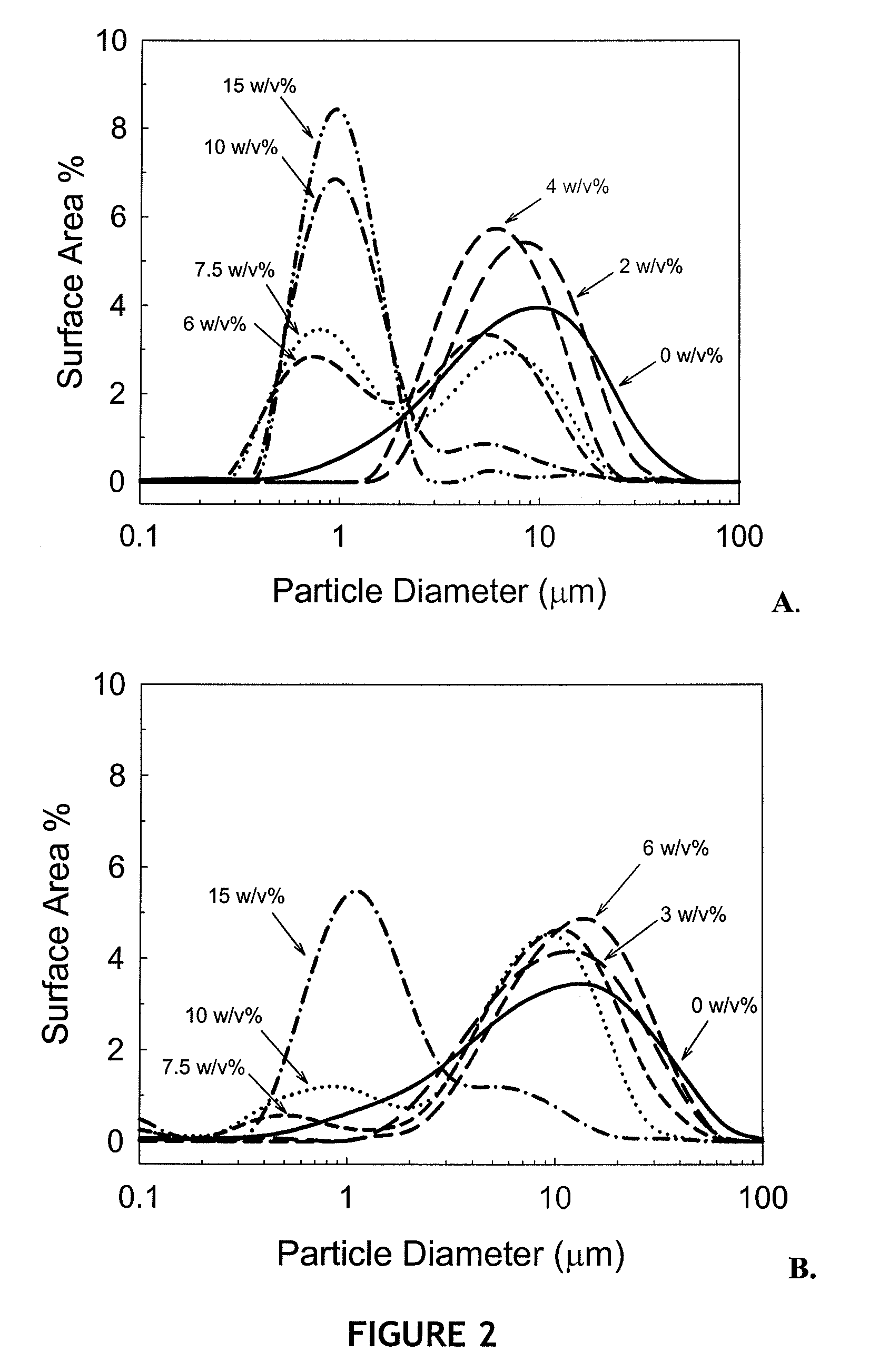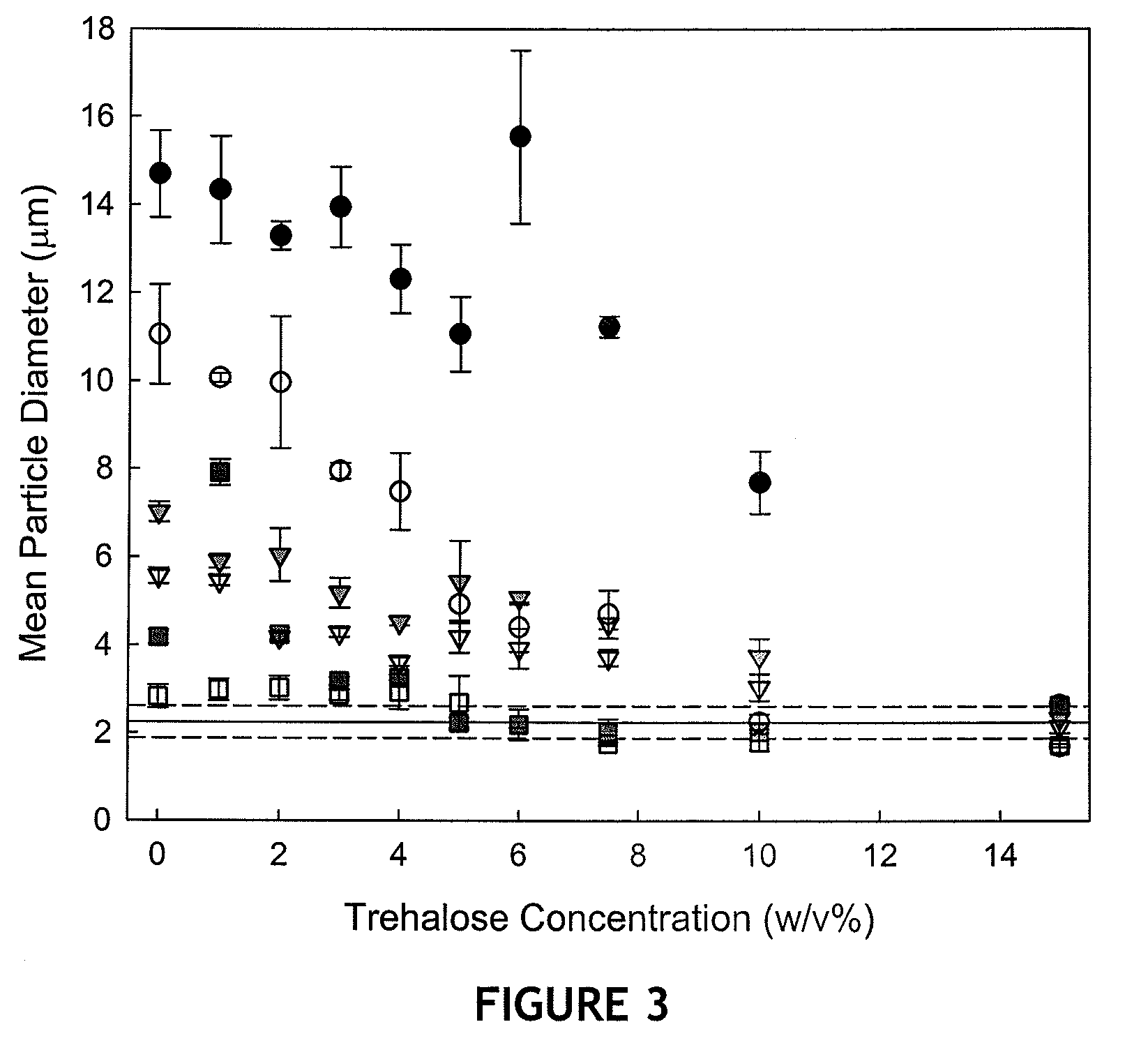Method of preparing an immunologically-active adjuvant-bound dried vaccine composition
a technology of immunologically active adjuvant and composition, which is applied in the direction of immunological disorders, antibody medical ingredients, lighting and heating apparatus, etc., can solve the problems of many proposed mechanisms being incorrect, unable to produce freeze-dried vaccine products containing adjuvants, and often losing potency
- Summary
- Abstract
- Description
- Claims
- Application Information
AI Technical Summary
Benefits of technology
Problems solved by technology
Method used
Image
Examples
example 1
Particle Size Distribution (PSD) of Aluminum Hydroxide Adjuvant Materials
[0107]Trehalose dehydrate (high purity, low endotoxin) was obtained from Ferro Pfanstiehl (Cleveland, Ohio). Succinic acid was purchased from Sigma Chemical Company (St. Louis, Mo.). Alhydrogel™ 2.0% (aluminum hydroxide adjuvant), made by Brenntag Biosector, was purchased through E.M. Sergeant Pulp & Chemical Co, Inc (Clifton, N.J.). 3-ml and 5-ml lyophilization vials and caps were obtained from West Pharmaceutical Services.
[0108]Aqueous solutions were prepared containing different concentrations of trehalose (0-15 w / v %). Unless otherwise noted, samples were prepared in 25 mM sodium succinate at pH 4.0 and contained 0.2 w / v % Alhydrogel™. Samples were processed as one-ml aliquots. With the exception of the adjuvant, all aqueous solutions were passed through a 0.2 μm filter prior to formulation.
Particle Aggregation Studies in Liquid Suspensions of Alhydrogel
[0109]To examine the effects of high...
example 2
Immune Response to Lysozyme Vaccines Containing Aluminum Salt Adjuvants Following Freeze-Thawing and Freeze-Drying Materials
[0148]Trehalose dehydrate (high purity, low endotoxin) was obtained from Ferro Pfanstiehl (Cleveland, Ohio). Succinic acid was purchased from Sigma Chemical Company (St. Louis, Mo.). Alhydrogel™ 2.0% (aluminum hydroxide adjuvant) and Adju-phos™ 2.0% (aluminum phosphate adjuvant), made by Brenntag Biosector, were purchased through E.M. Sergeant Pulp & Chemical Co, Inc (Clifton, N.J.). Lysozyme was obtained from Seikagaku Corporation (Japan). 3-ml and 5-ml lyophilization vials and caps were obtained from West Pharmaceutical Services.
[0149]Lysozyme was prepared as a 1 mg / ml solution. Endotoxins were removed using Detoxi-Gel AffinityPak Prepacked Columns from Pierce (Rockfort, Ill.). The lysozyme was then dialyzed to 25 mM sodium succinate, pH 4 using Slyde-a-Lyzer Dialysis Cassettes (10k MWCO) from Pierce (Rockfort, Ill.). After filtration throug...
example 3
Immune Response to Botulinum Neurotoxin C Vaccines Containing Aluminum Salt Adjuvants Following Freeze-Thawing and Freeze-Drying
Materials were as described in Example 2.
Efficacy Study of BotC Vaccine
[0163]Vaccines were prepared using rBotNTC (Hc) the sequence of which is shown in FIG. 11 (SEQ ID NO: 2), a recombinant protein antigen to C. botulinum neurotoxin C. Samples were freeze dried or spray freeze dried in 15% w / v % trehalose, 25 mM sodium succinate, pH 4.0 at a protein concentration of 150 μg / ml bound to 0.2 w / v % Alhydrogel. A liquid formulation of the same composition was prepared as a control. Samples that were freeze-dried and spray freeze-dried exhibited mostly unaggregated adjuvant PSD for both dried formulations.
[0164]The efficacy study was conducted by the US ARMY. Dried samples were reconstituted with 0.9 ml water prior to dilution. After reconstitution, samples concentrations were adjusted to 81 μg / ml rBotNTC(Hc) in 25 mM sodium succinate, 15 mM sodium phosphate, 8%...
PUM
| Property | Measurement | Unit |
|---|---|---|
| mean particle diameter | aaaaa | aaaaa |
| mean particle diameter | aaaaa | aaaaa |
| pH | aaaaa | aaaaa |
Abstract
Description
Claims
Application Information
 Login to View More
Login to View More - R&D
- Intellectual Property
- Life Sciences
- Materials
- Tech Scout
- Unparalleled Data Quality
- Higher Quality Content
- 60% Fewer Hallucinations
Browse by: Latest US Patents, China's latest patents, Technical Efficacy Thesaurus, Application Domain, Technology Topic, Popular Technical Reports.
© 2025 PatSnap. All rights reserved.Legal|Privacy policy|Modern Slavery Act Transparency Statement|Sitemap|About US| Contact US: help@patsnap.com



